Homemade Pasta Dough Recipe
Published January 18, 2024. This post may contain affiliate links. Please read my disclosure policy.
This Homemade Pasta Dough Recipe from scratch has few ingredients and comes together in just 1 hour. Once you eat fresh pasta, there is no going back to dried store-bought. It’s that good.
There is nothing like fresh pasta, and if you’re looking to try it out in a few recipes, try using it in my Lasagna Bolognese or Fettuccine Alfredo.
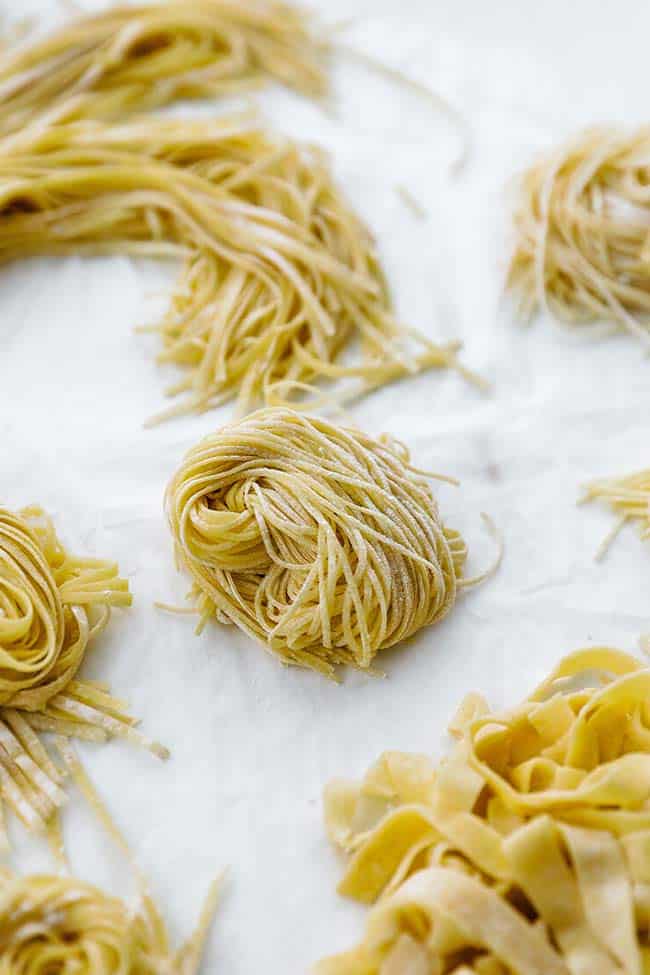
Homemade Pasta
Homemade pasta uses fresh dough created from flour and eggs that are kneaded, rolled, and shaped. There are hundreds of shapes, sizes, thicknesses, and colors of pasta, with spaghetti and macaroni being the two most popular here in the United States. My recipe is a typical egg pasta dough. However, water can be completely substituted for the eggs when making this.
Whether it’s spaetzle or pierogi, just about every country has their own version of pasta, even though it tends to be associated with Italy. They can be cut, cooked, and sauced, or stuffed like ravioli. Be sure to watch the video below of me making fresh pasta dough.
Ingredients and Substitutions
- Flour – I used a combination of 00 and semolina flour. However, you can substitute the 00 for bread flour. In addition, you can use all 00 or all semolian flour. Be sure the semolina flour is finely ground. In addition, all-purpose flour will work in place of the bread flour.
- Eggs – Large eggs at room temperature or chilled works well.
- Salt – I always use coarse salt in my cooking and baking.
- Liquid – When kneading the dough, it may need to be loosened to ensure it is hydrated and soft. If this is the case, you can add either water or olive oil to it.
How to Make Homemade Pasta Dough
- Measure out flours
- Sift Flours
- Form a well with the sifted flours.
- Add eggs to the center of the well. The rule of thumb is 1 egg per 100 grams of flour or heaping ¾ cup of flour.
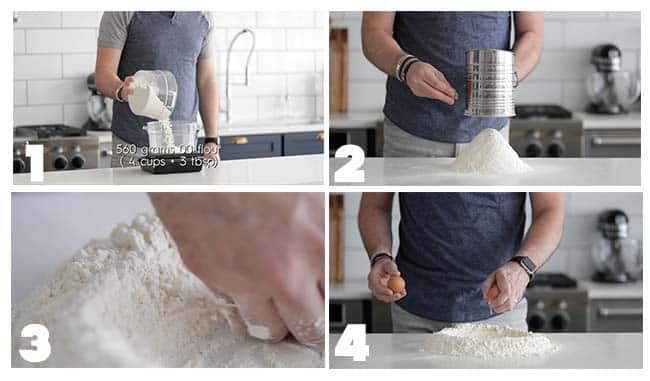
- Whisk the eggs.
- Begin to pull the flour from the inside of the well into the whisked eggs to combine using a fork.
- Completely combine the eggs with the flour. Use a bench knife to scrape together the ingredients.
- Once everything is combined, knead the dough for 12-15 minutes. The dough will be soft, smooth, and a light yellow color.
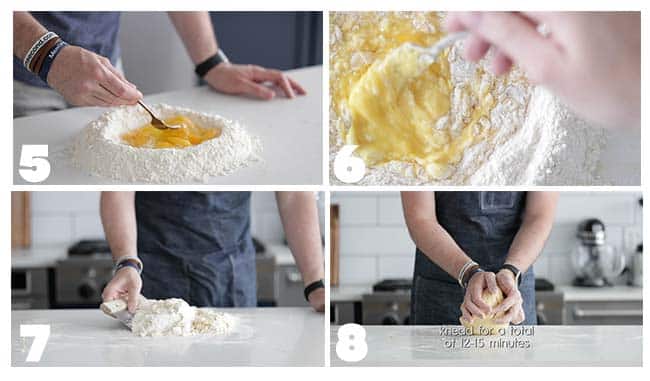
- Wrap the dough in plastic.
- Refrigerate the dough for 30 minutes.
- Remove the dough from the refrigerator and cut it into 3 pieces.
- Flatten 1 piece of the dough with your hands and lightly dust it with flour.
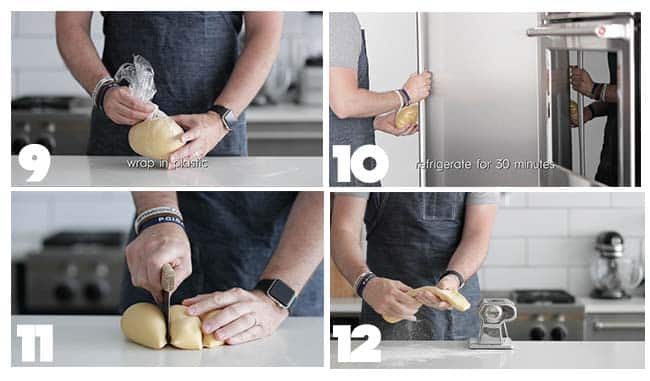
- On setting 0 on the pasta roller machine, run the flattened dough through 3 times.
- Cut the rolled-out dough in half.
- Change the pasta roller machine setting to 3 and run the dough through 3 times.
- Change the pasta roller machine setting to 6 and run the dough through 2 times. Repeat steps 12-16 until all the pasta dough has been used.
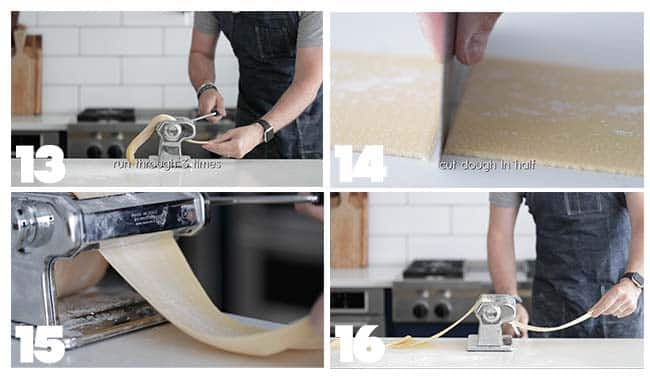
- Layout the dough on a dusted, clean surface and cut it into 12” – 14” inch pieces.\
- Using your favorite noodle attachment, run each 12”-14” piece of cut dough through the noodle attachment.
- Curl the noodle pasta into small, well-floured balls on a sheet tray lined with parchment paper. You can also dry your pasta on a drying rack.
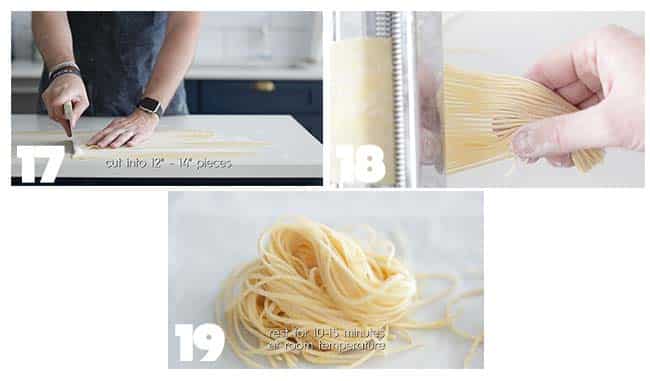
Make-Ahead and Storage
Make-Ahead: You can make this up to 1 day ahead of time for freshness.
How to Store: After the pasta has been rolled into little balls and dried for 10-15 minutes, cover it in plastic wrap and refrigerate it for up to 3 days. You can also freeze-wrap it in plastic wrap for up to 2 months. If you are freezing, you can add directly to boiling salted water from the freezer to cook.
How to Cook: Add your desired amount to a pot of boiling salted water and cook for 1 1/2 to 2 minutes.

CHEF NOTES + TIPS
- The dough can also be kneaded using a food processor. See my Ravioli Recipe for this technique.
- I believe homemade anything is better for you because you control the ingredients that go into it. In addition, oftentimes, there are preservatives and salt that can increase calories, fat, and sodium intake.
- There is absolutely no comparison between homemade fresh and store-bought pasta. Homemade tastes better cooks quicker and absorbs whatever sauce you put with it far better than any pre-made thing.
- If using it immediately, I think drying pasta for extended periods is a complete waste of time. The dough should still be slightly raw as it will cook quicker and taste fresher. Feel free to dry out your pasta only on a rack or in little balls for 10-15 minutes before cooking or storing.
- When using the KitchenAid pasta attachment, you would do the same thing as you did with the hand crank machine roller, including the width settings, to achieve the perfect finished product. I usually keep the speed setting under 3 so that you can pay attention when the pasta is running through.
- Hands down, the most important aspect of making homemade pasta dough is kneading it. I was always taught to knead it for 7-9 minutes and then knead it for another 5-7 minutes. If the dough is not properly kneaded, it will rip and tear when rolled out.
- The best flour for pasta is a bit subjective, and all lies in the eye of the beholder. I’m a bit of a traditionalist, so I believe a combination of 00 flour and semolina flour makes for a perfect dough that isn’t hard and not too soft.
Pasta Recipes

Video
Homemade Pasta Dough Recipe
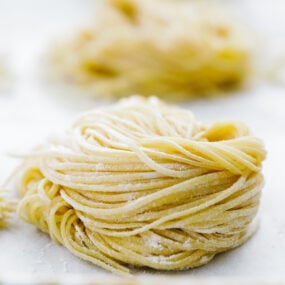
Ingredients
- 560 grams 00 flour, 4 cups + 3 tbsp
- 140 grams semolina flour, 3/4 cup + 1 ½ tbsp
- 7 eggs
Instructions
- Sift the flour onto a clean surface and then form a well with it.
- Add the eggs to the center of the well and whisk with a fork until combined and then slowly, add the flour from the edges.
- Once the egg and flour are combined, use a pastry knife to scrape the surface to bring it all together to form a dough.
- Knead for 12 to 15 minutes before wrapping in plastic and chilling in the refrigerator for 30 minutes.
- Remove the plastic from the dough and cut it into 3 pieces.
- Flatten 1 of the pieces of the dough with your hands and flour it lightly. Run it through the hand crank pasta maker on the 0 setting 3 times. Cut the dough in half.
- Turn the crank to 3 and run it through 3 times.
- Last, run it through on setting 6 twice. Dust with flour and place on a clean surface. Repeat the process with the remaining 2 dough balls.
- Cut the dough every 12”-14” inches long, dust it with flour on both sides and then run it through the spaghetti attachment or whatever desired noodle attachment you’d like. Dust again with flour, form it into a small ball, place it on a sheet tray lined with parchment paper, and rest it for 15 more minutes so that it dries out before cooking or storing.

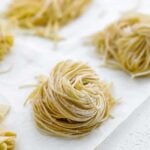
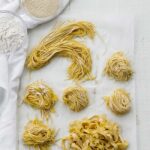
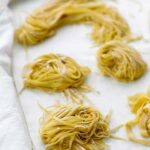
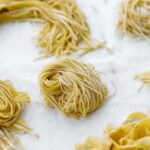
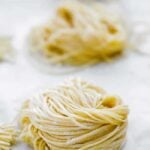
Can almond flour or oat flour be used in place of the 00? Do you absolutely need semolina flour? Trying to reduce gluten. And I’m new to that. Thank you!
No. You need gluten to make pasta.
Amazing! Followed the instructions, weighed my ingredients, and kneaded as directed. Delicious pasta, and had a blast making it! The video was super helpful, made a couple batches and froze to share. Thank you so much for sharing!
My pleasure. Appreciate you giving it a try!
I haven’t made this as yet. I will be ordering the pasta roller/cutter and will be trying this out after Christmas. Again I appreciate your videos very much! Thank you so much for all the education on cooking. My family has stopped buying processed foods so your homemade recipes are cherished. Thank you again and again. Please make more videos and what ever you do, DON’T RETIRE! LOL